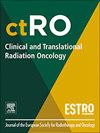Head and neck and skin (HNS) GEC-ESTRO and BRAPHYQS working groups joint critical review of the use of Rhenium-188 in dermato-oncology
IF 2.7
3区 医学
Q3 ONCOLOGY
引用次数: 0
Abstract
Non-melanoma skin cancers are increasing globally, prompting the need for innovative, non-invasive treatment approaches. Radioactive rhenium (188Re) paste has emerged as an open-source radiation-based modality in dermato-oncology, offering a novel alternative to conventional radiotherapy and brachytherapy. In this review, a systematic literature search was conducted using PubMed, Scopus, Web of Science, and Google Scholar for studies published over the past 20 years. Data were extracted from case series, pilot studies, and clinical trials, with particular emphasis on response rates, dosimetric parameters, and treatment-associated toxicity. Findings from approximately 240 patients demonstrated complete response rates ranging from 86 % to 100 % after one or two treatment applications, while dosimetric analyses revealed a rapid dose fall-off that effectively confines the therapeutic effect to a tissue depth of 2–3 mm, with most adverse effects being mild and transient. Notably, 188Re differs from conventional brachytherapy (specifically high-dose-rate modality) due to its open-source application and unique dosimetric profile. The use of 188Re in clinical practice mandates a highly specialized, multidisciplinary team, including radiation oncologists, nuclear medicine specialists, and experienced medical physicists, and strict quality assurance protocols, thereby limiting its application to carefully selected cases.
Although 188Re therapy offers a promising alternative for the treatment of superficial skin cancers, its distinct clinical and dosimetric characteristics warrant further randomized studies with extended follow-up to validate its efficacy and refine patient selection criteria under rigorous multidisciplinary oversight.
头颈部和皮肤(HNS) GEC-ESTRO和BRAPHYQS工作组联合审查铼-188在皮肤肿瘤学中的应用
非黑色素瘤皮肤癌在全球范围内不断增加,这促使人们需要创新的、非侵入性的治疗方法。放射性铼(188Re)膏体已成为皮肤肿瘤学中基于开放源代码的放射治疗方式,为传统放射治疗和近距离治疗提供了一种新的选择。在这篇综述中,我们使用PubMed、Scopus、Web of Science和b谷歌Scholar对过去20年发表的研究进行了系统的文献检索。数据来自病例系列、前期研究和临床试验,特别强调反应率、剂量学参数和治疗相关毒性。大约240名患者的研究结果表明,在一次或两次治疗后,完全缓解率从86%到100%不等,而剂量学分析显示,剂量迅速下降,有效地将治疗效果限制在2-3毫米的组织深度,大多数不良反应是轻微和短暂的。值得注意的是,188Re不同于传统的近距离治疗(特别是高剂量率模式),因为它的开源应用和独特的剂量学特征。在临床实践中使用188Re需要一个高度专业化的多学科团队,包括放射肿瘤学家、核医学专家和经验丰富的医学物理学家,以及严格的质量保证协议,从而将其应用限制在精心挑选的病例中。尽管188Re疗法为浅表性皮肤癌的治疗提供了一个很有前景的选择,但其独特的临床和剂量学特征需要进一步的随机研究,并延长随访时间,以验证其疗效,并在严格的多学科监督下完善患者选择标准。
本文章由计算机程序翻译,如有差异,请以英文原文为准。
求助全文
约1分钟内获得全文
求助全文
来源期刊

Clinical and Translational Radiation Oncology
Medicine-Radiology, Nuclear Medicine and Imaging
CiteScore
5.30
自引率
3.20%
发文量
114
审稿时长
40 days
 求助内容:
求助内容: 应助结果提醒方式:
应助结果提醒方式:


